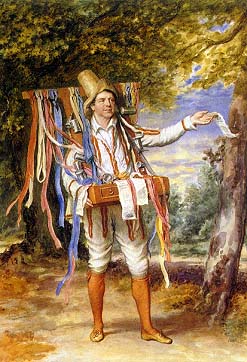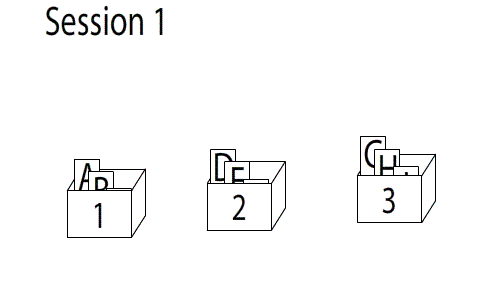Cards have a prominent history in the early modern period. Nicholas Tosney writes in Historical Research that
By the sixteen-eighties over one million packs of playing cards were being produced every year.Tosney appears mostly interested in the ways that cards helped governments raise revenue. But the article raises other questions about the nature of playing cards. For instance, did balladeers like Autolycus sell playing cards? What is the purpose and design of playing cards?

"Wageman - Fawcett as Autolycus" by Thomas Charles Wageman (1768-1837) - Shakespeare Illustrated. Licensed under Public Domain via Wikimedia Commons.
1. Stack
The design of playing cards is especially relevant as people try to make digital substitutes. Like other early modern print genres--including newspapers, almanacs, and horoscopes--cards are adapting to the digital era. Ezra Klein's born-digital news platform, Vox, organizes content around "card stacks." AdAge explains the conceit:To better explain the news, Vox.com is trying a new way of presenting information on topics in what its calling Card Stacks. The card metaphor came after the founding team started playing with the idea of what it means to provide context to the news. "We had a cool idea that context is a consistent layer of where you are in the site, and card stacks pop up and are easy to flip through," said Vox Media's chief product officer Trei Brundrett.For Vox, the "card stack" provides a physical model for historical and networked information.
Playing cards can be stacked in categories without losing their efficacy. Books benefit from bookshelves; paintings need wallspace; even newspapers come with their own tidy organization. But cards are the flat-packed, IKEA-approved, hyper-stackable medium. That's what we learn from the way that Vox uses card stacks, and other digital platforms highlight other characteristics of cards.
2. Flip
NPR reports that TOPPS developed an app to simulate baseball card collecting. And this app, like all things digital, has a twitter feed:
You knew @TOPPSMIKE wasn't going to do a World Series Winners set without the Yankees, right? http://t.co/y1fBN4zcgL pic.twitter.com/puAdi0jyL2
— Topps BUNT (@ToppsBUNT) January 2, 2015
Some of the BUNT's features are throwbacks to a dead medium--like their digital bubble gum. The app incorporates an animation of bubble gum that I would call a skeuomorph. And this skeuomorph recreates the process of revealing a card.Baseball cards, playing cards, even tarot cards rely on the interplay of concealing and revealing. The conceal/reveal emerges from play between "recto" and "verso" sides. One side of the card can obsolesce, enhance, retrieve, or reverse the other side of the card. The other card that benefits from flipping is, of course, the flash card.
3. Shuffle
Whereas those other cards flip to shock, entrance, or delight, flash cards flip to instruct. As Slate reports, the educational flash card probably began with John Stuart Mill:Of course I can't resist including Rowlandson's image of Bissett's larnd pig:One of the earliest recorded flashcard success stories appears in the Autobiography of John Stuart Mill. In 1810, James Mill began teaching his three-year-old son Greek using what we would now call flashcards. "My earliest recollection on [learning Greek]," Mill writes, "is that of committing to memory what my father termed vocables, being lists of common Greek words, with their signification in English, which he wrote out for me on cards."Predating Mill by a few decades was an even more precocious case of card learning, this time by a porcine pupil. In the 1780s, an animal trainer named Samuel Bissett toured Ireland with a pig that he had taught to do math problems and spell, using cards labeled with letters and numbers.
"Rowlandson, The Wonderful Pig, 1785" by Thomas Rowlandson - http://georgianaduchessofdevonshire.blogspot.com/2008_09_01_archive.html. Licensed under Public Domain via Wikimedia Commons.
The flash card combines the flip with the technique of the shuffle. According to Spaced Repetition or the Leitner system,the complex sortation of the cards works against the memory's normal systems of forgetting. In other words, flash cards mostly work because they're shuffled.

"Leitner system animation" by Zirguezi - Own work. Licensed under CC0 via Wikimedia Commons.
4. Keep
Of course every other use of cards depends on the durability of cards. Cards were made of cardstock, and so were ideally conditioned for preservation and re-use. Therefore we have postcard preservation in Boston, Chicago, South Jersey, New York, and Illinois, just to name the first page of Google results. Likewise, we have playing card museums around the world, and too many baseball card collectors to name.And the card itself is a miniature museum. A flash card promises that it can force an association between two ideas. A baseball card promises to distill a player's career into a set of facts that can fit into your pocket. A postcard or a greeting card resembles a fragment of a vacation: often nothing more than a collage of bright colors and strange sights, compounded into the shape of the word "WISCONSIN" or "HAWAII." And throughout these, the tarot deck offers to unveil the history of the cosmos to anyone with the patience to keep the deck, shuffle, stack, and flip the cards.
No comments:
Post a Comment